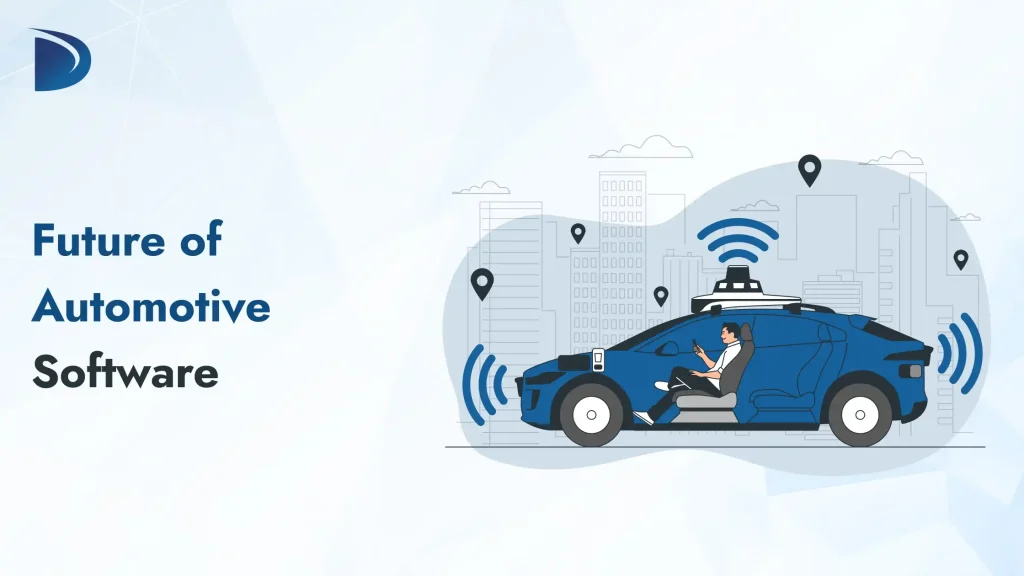Table of Contents
The future of automotive software is steering the industry into a new era of mobility. No longer driven solely by engines and steel, it now runs on data, connectivity, and smart code. From automotive manufacturing software to real-time vehicle diagnostics and OTA updates, software is reshaping how cars are built, sold, and experienced.
With automotive technology trends accelerating and emerging technologies in the automotive industry disrupting the status quo, brands must evolve fast. This blog explores the key trends, innovations, and digital shifts shaping the future and how Differenz System is helping to lead the way.
What is Automotive Software?
Automotive software refers to the digital systems, applications, and platforms that power everything from vehicle diagnostics and infotainment to advanced driver assistance and autonomous driving. It’s the technology layer that turns modern cars into intelligent, connected machines.
Today’s vehicles are innovative, responsive, and constantly evolving. With automotive industry software, manufacturers can manage all aspects of their operations. This shift is driving significant improvements in automotive safety, efficiency, and user experience. As technology in the automotive industry advances, software is at the core.
How Automotive Technology Trends Are Accelerating the Shift to Software-Defined Vehicles
Cars are becoming rolling computers. What used to be mechanical is now digital, and automotive technology trends are accelerating this shift. Features such as real-time connectivity, driver assistance, voice control, and remote updates are now expected. And that’s only possible because of the rise of software-defined vehicles.
This shift is being fueled by a range of factors, including 5G, AI, cloud platforms, and over-the-air updates. These new trends in the automotive industry are about building vehicles that evolve long after they leave the factory. As technology trends in the automotive sector continue to accelerate, manufacturers and suppliers have to think more like software companies.
Who’s Powering Innovation in the Automotive Industry?
Major Automakers & Tech Giants
- Toyota just launched its Arene software platform in the sixth-generation RAV4, marking the brand’s official push into software-defined vehicles.
- Volvo is bringing Google’s AI chatbot Gemini into its cars, enhancing the in-cabin experience with natural-language voice control and live translations, another leap in automotive technology trends.
Emerging Trends & Market Growth
- The software-defined vehicle (SDV) market is projected to soar from $213 billion in 2024 to $1.23 trillion by 2030, a 34% CAGR across platforms and E/E architectures.
- At CES 2025, automakers showcased a range of innovations, from AI-driven ADAS and OTA platforms to digital cockpits, signaling a broader shift in current automotive trends.
When Did the Rise of Automotive IT Trends Begin and What’s Coming?
The rise of automotive IT trends has been building for years. It began with basic features like navigation and diagnostics, but over the last decade, the shift has accelerated very quickly. With AI, cloud connectivity, and real-time updates becoming standard, software is now at the heart of how cars are built and how they perform.
This evolution is steering the future of the automotive industry toward software-defined vehicles, cars that can improve, adapt, and personalize themselves through software code. As new technology in the automotive industry continues to evolve, vehicles are becoming increasingly intelligent, connected, and flexible than ever before.
Challenges Facing the Future of Automotive Manufacturing
Outdated Systems & Fragmented Processes
Legacy vehicle architectures (old ECUs and siloed production environments) are choking innovation. Many workshops and factories weren’t designed for the agile, software-centric world of software-defined vehicles. Upgrading them means rethinking the entire workflow, not just installing a few servers.
Scaling CI/CD Across Vehicles
In traditional software, updates are pushed out overnight. In cars, each update needs extreme testing (MiL, SiL, HiL) to ensure safety and reliability. This makes broad rollouts of OTA updates a logistical and regulatory headache.
Cybersecurity & Data Privacy
Connected cars are goldmines for hackers. From CAN bus exploits to vehicle-to-cloud data leaks, every system has potential vulnerabilities. OEMs must incorporate robust cybersecurity protocols while meeting standards such as ISO/SAE 21434, UNECE R155, and GDPR.
Regulatory Complexity
Safety, privacy, and OTA standards vary by region, including the EU’s UNECE R155/R156, the U.S. federal-state patchwork, and China’s strict data laws. General software no longer cuts it. OEMs must tailor systems to overlapping rules while avoiding costly delays.
Talent & Culture Shift
Creating cars that update like smartphones requires a whole new skill set. Many legacy OEMs still think like manufacturers, not software platforms. Companies like Volkswagen and Toyota recognize that they need to hire differently, form agile teams, and adopt a startup mindset to remain competitive.
Why Partner with Differenz System?
Building the future of automotive isn’t just about more technology; it’s about choosing the right technology partner. At Differenz System, we understand the pressure automotive brands face: staying ahead of automotive technology trends, adapting to software-defined vehicles, and delivering innovation without breaking continuity.
We bring deep expertise in automotive industry software, combined with agile development, cloud-first thinking, and scalable architectures. And we don’t just code and ship. We collaborate, challenge assumptions, and bring clarity to complex digital transformations.
So, if you’re ready to turn bold ideas into road-ready solutions, let’s build the future together.
Conclusion
The future of automotive is racing toward a digital-first reality. With software-defined vehicles, cloud-based platforms, and more innovative production tools becoming the norm, staying relevant means staying adaptable. This shift is about leading the latest trends in the automobile industry.
At Differenz System, we help you rethink what’s possible with automotive industry software. From advanced automotive manufacturing software to next-gen mobility platforms, we’re here to drive your transformation from the inside out.
FAQs
What are software-defined vehicles (SDVs)?
SDVs are vehicles where software controls most of the functionality. They represent the future of automotive and rely heavily on centralized computing and OTA capabilities.
Why is the shift to software critical for the future of automotive manufacturing?
As vehicles become more intelligent and more connected, manufacturers require flexible, scalable platforms to support ongoing updates and customer-driven innovation. That’s only possible with a software-first approach.
How do software-defined vehicles impact the end-user experience?
They offer personalized driving experiences, continuous feature upgrades, predictive maintenance alerts, and enhanced safety, all powered by automotive industry software that evolves with time.

